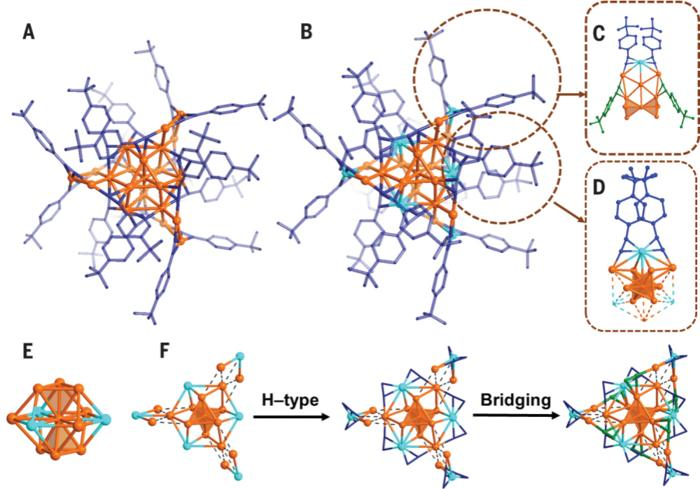In collaboration with Prof. Quanming Wang’s team at Tsinghua University (THU), the research team led by Prof. Meng Zhou from the University of Science and Technology of China (USTC) of the Chinese Academy of Sciences (CAS) attained near-unity room-temperature photoluminescence quantum yield (PLQY) (>99%) in the near-infrared (NIR) emission of metal nanoclusters in solution. Science published their study.
 Molecular structures of Au22 and Au16Cu6 and structure anatomy of Au16Cu6. Image Credit: Prof. ZHOU’s team
Molecular structures of Au22 and Au16Cu6 and structure anatomy of Au16Cu6. Image Credit: Prof. ZHOU’s team
The NIR-emissive properties of gold nanoclusters (Au NCs) make them promising for biomedical applications. Nonetheless, Au NCs’ PLQY in the near-infrared spectrum is normally low—often less than 10%. Au22(tBuPhC≡C)18(Au22) and its copper-doped twin, Au16Cu6(tBuPhC≡C)18 (Au16Cu6), were synthesized to explore their photophysical characteristics and solve this problem.
An X-Ray diffraction examination of a single crystal revealed structural similarities between Au22 and Au16Cu6. Au16Cu6 emitted light at 720 nm, while Au22 emitted light at 690 nm. Au22 and Au16Cu6 have absolute PLQYs in the air of 9% and 95%, respectively.
Both absolute and relative measurements of Au16Cu6’s PLQY in deaerated solution showed 100%. The photoluminescence lifetimes of Au22 and Au16Cu6 were determined to be 485 ns and 1.64 μs, respectively, by time-correlated single-photon counting.
Both of the NCs’ luminescent states started from the triplet state (T1), with separate dynamic processes detected in femtosecond transient-absorption spectroscopy, according to further examination of the excited-state dynamics of NCs using this technique. Au22 exhibited a gradual increase of 148 ps under 380 nm excitation, whereas Au16Cu6 exhibited a fast relaxation of 0.5 ps.
Triplet sensitization tests demonstrated that these processes are caused by ultrafast intersystem crossing (ISC) from the singlet state (S1) to T1. Copper doping reduces Au16Cu6’s ∆Est, resulting in a substantial acceleration in its ISC rate. As a result, Au16Cu6 finally shows PLQY close to 100%.
The strategy for achieving near-unity PLQY might lead to the production of extremely emissive metal cluster materials. Specifically, this study shows that an alloy of gold-copper nanoclusters can produce near-unity PLQY even in solution at ambient temperature, allowing for applications ranging from biological imaging to luminescent devices.
Journal Reference:
Shi, W.-Q., et. al. (2024) Near-unity NIR phosphorescent quantum yield from a room-temperature solvated metal nanocluster. Science. doi:10.1126/science.adk6628